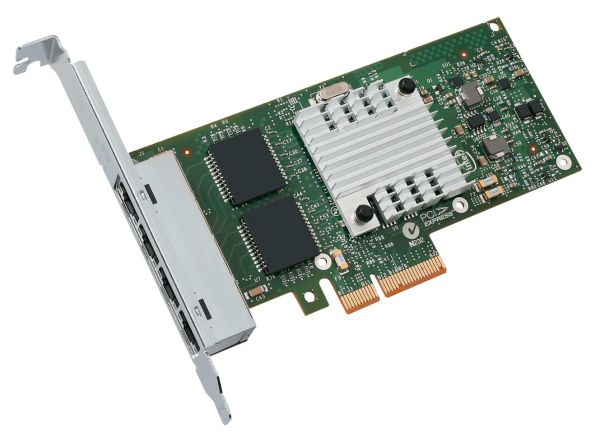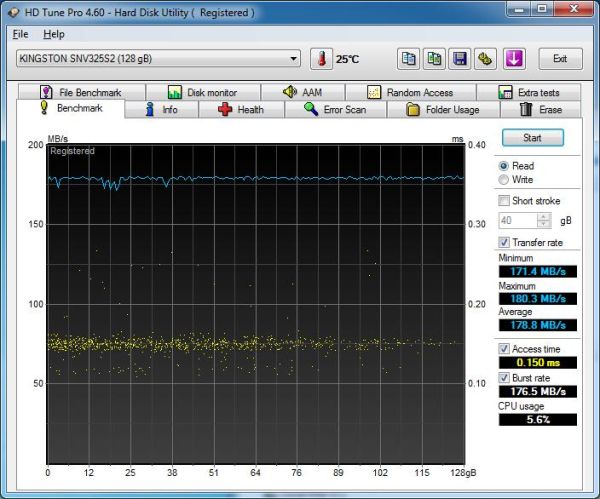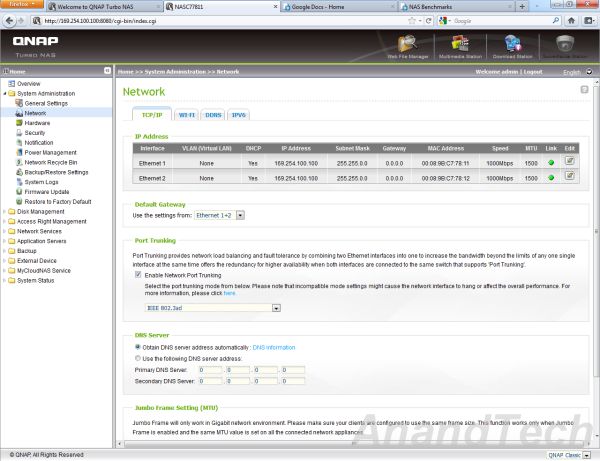QNAP TS-659 Pro II Review
by Ganesh T S on September 19, 2011 8:00 AM EST- Posted in
- IT Computing
- NAS
- QNAP
For the purpose of NAS reviews, we have setup a dedicated testbed with the configuration as below. The NAS is directly connected to the testbed (using as many Cat 5E cables as there are ports on the NAS) without a switch or router inbetween. This is done in order to minimize the number of external factors which might influence the performance of the system.
| NAS Benchmarking Testbed Setup | |
| Processor | Intel i5-680 CPU - 3.60GHz, 4MB Cache |
| Motherboard | Asus P7H55D-M EVO |
| OS Hard Drive | Seagate Barracuda XT 2 TB |
| Secondary Drive | Kingston SSDNow 128GB |
| Memory | G.SKILL ECO Series 2GB (1 x 2GB) SDRAM DDR3 1333 (PC3 10666) F3-10666CL7D-4GBECO CAS 7-7-7-21 |
| PCI-E Slot | Quad-Port GbE Intel ESA-I340 |
| Optical Drives | ASUS 8X Blu-ray Drive Model BC-08B1ST |
| Case | Antec VERIS Fusion Remote Max |
| Power Supply | Antec TruePower New TP-550 550W |
| Operating System | Windows 7 Ultimate x64 |
| . | |
In addition to the Realtek GbE NIC on-board the Asus P7H55D-M EVO, four more GbE ports are enabled on the system, thanks to the Intel ESA-I340 quad port GbE ethernet server adapter . With a PCI-E x4 connector, the card was plugged into the PCI-E x16 slot on the Asus motherboard.
Two of the four ports are teamed together as shown in the video below below during the benchmarking.
Intel NASPT is used to benchmark the NAS device. In order to ensure that the hard disk transfer rate is not a bottleneck, NASPT is run from the secondary drive in the testbed (the Kingston SSD). With average read and write speeds of 178.8 MB/s and 167.8 MB/s, it is unlikely that a single GbE link NAS can be limited in performance due to the test system. However, a link aggregated NAS could be affected. Fortunately, as we will see in the next few sections, this wasn't the case for the TS-659 Pro II.
All file copy tests were also performed using the SSD. The file copy test consists of transferring a 10.7 GB Blu-Ray folder structure between the NAS and the testbed using the robocopy command in mirror mode.
There are three important sharing protocols we investigated in the course of our evaluation of the TS-659 Pro II. In the next few sections, you will find NASPT / robocopy benchmarking results for Samba, NFS and iSCSI sharing protocols. Each section also has a small description of how the shares were set up on the NAS. The NASPT benchmarks were run in Batch mode thrice, giving us 15 distinct data points. The average of these 15 values is recorded in the graphs presented in the following sections. The robocopy benchmark was run thrice, and the average transfer rate of the three iterations is presented alongside the NASPT benchmarks.
The TS-659 Pro II supports multiple RAID configurations, but we believe that most of the users will end up running this in RAID-5. So, all our benchmarks are collected with the disks configured in a RAID-5 volume. The GbE ports were configured for dynamic link aggregation (802.3ad) as shown below:
Note that the 6 x 1 TB disks result in a total available space of arund 4600 GiB (shows up as GB on the NAS configuration webpage) when configured in RAID-5. This is due to a couple of maintenance partitions created by the QNAP firmware. Each 1 TB disk is partitioned as below.















69 Comments
View All Comments
chris1317 - Tuesday, September 20, 2011 - link
Yeah it is good that there is also RADI6 support. QNAP My TS-509 supports RAID6 but I am unwilling to sacrafice 2/5 drives for raid thats why im holding out and saving up for either the 8 bay or 10 bay model.DanNeely - Monday, September 19, 2011 - link
I don't agree with your conclusions about the non-usefulness of USB3 vs eSata. Granted supporting quick copy on both would be best; but among non-technical users USB drives are significantly more common than eSata and over the next year or two I expect most of them to become USB3 enabled. Backing up to an external HD is a common pattern, so a lot of 1st time NAS users will probably have data to import this way.Kevin G - Monday, September 19, 2011 - link
Minor differences between the chart and the article on the first page. "Internally, the dual core Atom D525 runs at 1.73 GHz and has four execution threads..." while the chart indicates a flat 1.8 Ghz.ganeshts - Monday, September 19, 2011 - link
The 1.73 GHz is from /proc/cpuinfo ; Any other claim is just marketing specs (which I clearly mention before putting up the specs).schumaku - Wednesday, September 21, 2011 - link
TS-459 Pro II, V3.5.0 Build 0815T[~] # cat /proc/cpuinfo
processor : 0
vendor_id : GenuineIntel
cpu family : 6
model : 28
model name : Intel(R) Atom(TM) CPU D525 @ 1.80GHz
stepping : 10
cpu MHz : 1795.701
...
processor : 1
...
model name : Intel(R) Atom(TM) CPU D525 @ 1.80GHz
stepping : 10
cpu MHz : 1795.701
...
processor : 2
...
model name : Intel(R) Atom(TM) CPU D525 @ 1.80GHz
stepping : 10
cpu MHz : 1795.701
...
processor : 3
...
model name : Intel(R) Atom(TM) CPU D525 @ 1.80GHz
stepping : 10
cpu MHz : 1795.701
ganeshts - Wednesday, September 21, 2011 - link
I rechecked the NAS, and it is indeed 1795 MHz. Sorry, fixed.XZerg - Monday, September 19, 2011 - link
I don't find NAS at all worthy and their performance/price are even worse than what you can do with a 10 years old computer and a gigabit card. Maybe not 10 years old but 6-7 years would be great instead. I have had a NAS, DLink DNS-323, which I sold after a year of not much of a great use for $100 ($130+6% tax originally paid). Even though it was a Gigabit NAS the performance on that was just pathetic, think in 3-4MBps for most tasks, including copying movies which would go up to 10 or so MBps. Once I bought my new laptop, I basically converted my old computer (Sempron 3100+ 32bit system) into my NAS and I easily got 40-50MBps over LAN. I upgraded that after to something newer (X2 4600 with 785G chipset) and now it servers as a media center too replacing my DVD player as well.Given their performance and their price, why would anyone want to get a NAS over say even a nettop systems which will too easily outpace them? Some of these NAS, take QNAP TS-659 Pro II for example, cost $1000+. Hell for that price I can easily setup a very decent low-end system with 5x2TB drives and some SSDs too and still have money to add more. So why?
DanNeely - Monday, September 19, 2011 - link
Quality NAS hardware, as opposed to cheap junk like your $100 Dlink box, are full fledged computers in SFF cases and can be more compact than anything you can build yourself. eg HPs 4 drive WHS boxes are half the size of the smallest 4 bay MiniITX case I could find.If the size of the device isn't a concern, you can build your own hardware, and install/configure/admin a linux file server yourself then there's really not any reason for you to buy a NAS. OTOH if you want something that just works out of the box because you value your free time highly, or are a SMB without a dedicated geek (or your geek is already swamped and you can't afford a second) then the cost of a good prebuilt NAS with idiot friendly web config pages, is less than hiring a contractor/etc to build and maintain a homebuilt server for you.
MTN Ranger - Monday, September 19, 2011 - link
Stepping up to a better quality NAS such as a Synology DS210 offers much higher performance. I regularly get over 60MBps on my gigabit LAN.jmelgaard - Monday, September 19, 2011 - link
Did you actually read the article?... Did you miss the page where they measured performance, or did you just assume it was impossible to reproduce those numbers under real life situations?Have a QNAP 859 Pro my self, chosen for pure convenience as putting together a NAS box that would fill the same set of requirements would be a picky task not to mention the time put in to it in terms of build and installation...
Copying a ~10GB directory, a VMWare virtual machine in my case, gives me the following (Large files, 1GB-2GB pr file for most of the 10GB):
- NAS to Workstation: 86MB/s
- Workstation to NAS: 55MB/s
Copying ~9GB directory with images (small Files, 2-5MB):
- NAS to Workstation: 45MB/s
- Workstation to NAS: 44MB/s
My workstation has 3 x 240GB Vertex 3 SSD's hooked up to a LSI MegaRaid 9265-8i controller, so there should be absolutely no bottleneck there, I run with Dual 1Gbit link for the NAS in fail-over mode, and only a single 1Gbit link in the Workstation, The NAS has 8 x SAMSUNG Spinpoint F3EG (Green, HD203WI 1AN1) in RAID 5...
As expected It can't give the same throughput when writing to it as reading, has to calculate parity after all, also dealing with lots of small files has it's penalties compared to large files, also something I did expect.
But building your own NAS does have advantages for sure, so if one bothers there is gains like the flexibility you can give it and that you have a more "limitless" ability to expand, well to a certain degree but properly far beyond your needs, also 10Gbit links are more available although QNAP has just release a new series that can be upgraded to 10Gbit, but to utilize that we are talking SSD's and uhm... that will become rather expensive and I would have to say that I could not see the case for it...
But these "In a box" solutions is far from as bad as you seem to think of them...